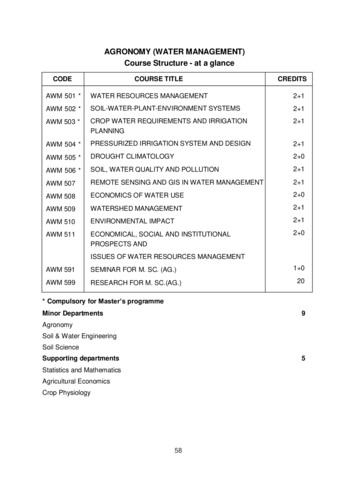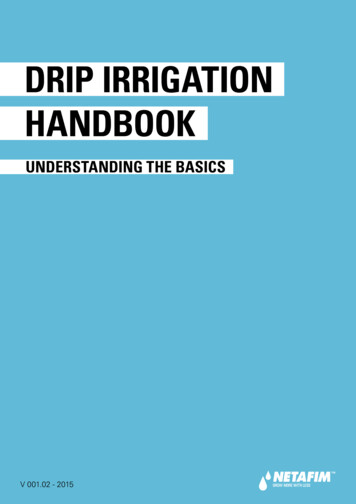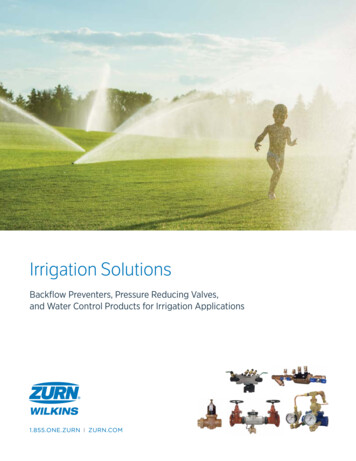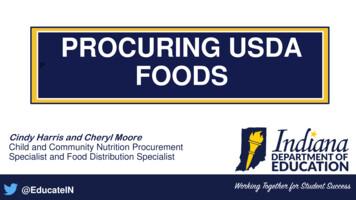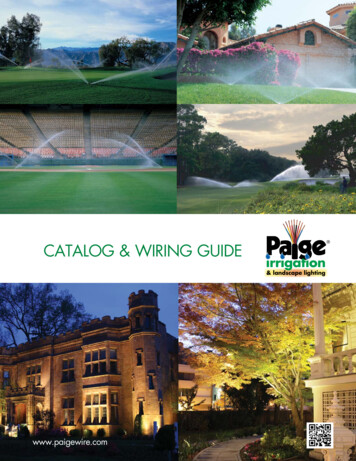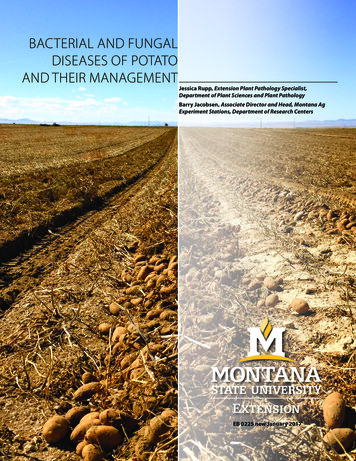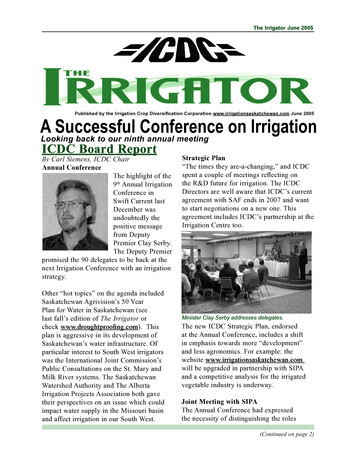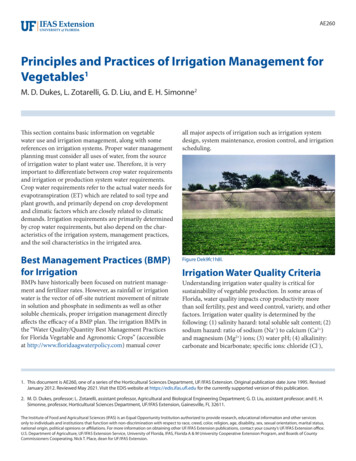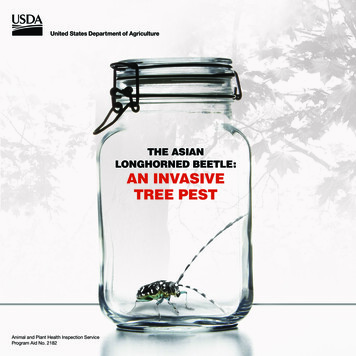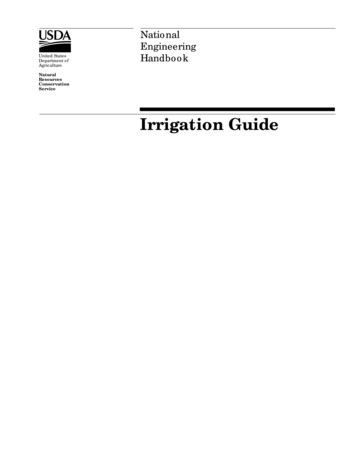
Transcription
United StatesDepartment ofAgricultureNationalEngineeringHandbookPart 652Irrigation GuideNaturalResourcesConservationServiceIrrigation Guide(210-vi-NEH, September 1997)v
Part 652Irrigation GuideIssued September 1997The United States Department of Agriculture (USDA) prohibits discrimination in its programs on the basis of race, color, national origin, sex, religion,age, disability, political beliefs, and marital or familial status. (Not all prohibited bases apply to all programs.) Persons with disabilities who requirealternative means for communication of program information (Braille, largeprint, audiotape, etc.) should contact USDA’s TARGET Center at (202) 7202600 (voice and TDD).To file a complaint, write the Secretary of Agriculture, U.S. Department ofAgriculture, Washington, DC 20250, or call 1-800-245-6340 (voice) or (202)720-1127 (TDD). USDA is an equal employment opportunity employer.vi(210-vi-NEH, September 1997)
PrefacePart 652Irrigation GuideIrrigation is vital to produce acceptable quality and yield of crops on aridclimate croplands. Supplemental irrigation is also vital to produce acceptable quality and yield of crops on croplands in semi-arid and subhumidclimates during seasonal droughty periods. The complete management ofirrigation water by the user is a necessary activity in our existence as asociety. Competition for a limited water supply for other uses by the publicrequire the irrigation water user to provide much closer control than everbefore. The importance of irrigated crops is extremely vital to the public'ssubsistence.Today's management of irrigation water requires using the best informationand techniques that current technology can provide in the planning, design,evaluation, and management of irrigation systems. Support for many of thevalues included in this chapter come from field research, established designprocesses, and many system designs and evaluations over many years. Fieldevaluations must always be used to further refine the planning, design,evaluation, and management process. This design guide in the NaturalResources Conservation Service (NRCS), National Engineering Handbookseries provides that current technology.Irrigation Guide, Part 652, is a guide. It describes the basics and process forplanning, designing, evaluating, and managing irrigation systems. It provides the process for states to supplement the guide with local soils, crops,and irrigation water requirement information needed to plan, design, evaluate, and manage irrigation systems.Irrigation Guide, Part 652, is a new handbook to the family of references inthe NRCS, National Engineering Handbook series. It is written for NRCSemployees who provide technical assistance to the water user with concerns for both water quantity and quality. Other technical personnel forFederal, State, private, and local agencies will also find the guide useful as abasic reference when providing technical assistance relating to planning,designing, evaluating, and managing irrigation systems. College and university instructors will also find the guide useful as a classroom reference.In addition to the irrigation Guide (part 652), chapters in the NationalEngineering Handbook irrigation section (now part 623) describe: Soil-plant relationships and soil water properties that affect movement, retention, and release of water in soil Irrigation water requirements Planning farm irrigation systems Measurement of irrigation water Design of pumping plants Design criteria and design procedures for surface, sprinkler, andmicro irrigation methods and the variety of systems for each methodthat can be adaptable to meet local crop, water, and site conditionsand irrigation concerns(210-vi-NEH, September 1997)i
AcknowledgmentsPart 652Irrigation GuidePart 652, Irrigation Guide, is an addition to the National Engineering Handbook series. The document was initially prepared by Elwin A. Ross, irrigation engineer, NRCS, Engineering Division, Washington, DC, (retired) withprimary input and review from Leland A. Hardy, irrigation engineer,Midwest National Technical Center, NRCS, Lincoln, Nebraska, (retired).Principal NRCS staff who contributed to the development and review ofthis publication were:John Brenner, irrigation engineer, North Platt, NebraskaJerry Walker, irrigation engineer, Temple, TexasCarl Gustafson, state conservation engineer, Amherst, MassachusettsDavid Nelson, assistant state conservation engineer, Amherst,MassachusettsJohn Dalton, agricultural engineer, Bozeman, Montana (retired)Jim Suit, state conservation engineer, Bozeman, MontanaState conservation engineers coordinated a multidiscipline (representingsoils, agronomy, water quality, and water management) review in all states.William J. Carmack, national water management engineer, (retired),Ronald L. Marlow, water management engineer, NRCS, Washington, DC,and Thomas L. Spofford, irrigation engineer, NRCS, National Water andClimate Center, Portland, Oregon provided leadership and coordination.Editing and publication production assistance were provided by the Technical Publishing Team, NRCS, National Cartography and Geospatial Center,Fort Worth, Texas. Final technical review was provided by Elwin A. Rossand Leland A. Hardy.ii(210-vi-NEH, September 1997)
Part 652Irrigation GuideIrrigation GuideContents:Chapter 1IntroductionChapter 2SoilsChapter 3CropsChapter 4Water RequirementsChapter 5Selecting an Irrigation MethodChapter 6Irrigation System DesignChapter 7Farm Distribution ComponentsChapter 8Project and Farm Irrigation Water RequirementsChapter 9Irrigation Water ManagementChapter 10Conservation Management Systems and Irrigation PlanningChapter 11Economic EvaluationsChapter 12Energy Use and ConservationChapter 13Quality of Water SupplyChapter 14Environmental ConcernsChapter 15Resource Planning and Evaluation Tools and WorksheetsChapter 16Special Use Tables, Charts, and ConversionsChapter 17Glossary and ReferencesIndex(210-vi-NEH, September 1997)iii
Part 652Irrigation GuideIrrigation GuideContents:Chapter 1IntroductionChapter 2SoilsChapter 3CropsChapter 4Water RequirementsChapter 5Selecting an Irrigation MethodChapter 6Irrigation System DesignChapter 7Farm Distribution ComponentsChapter 8Project and Farm Irrigation Water RequirementsChapter 9Irrigation Water ManagementChapter 10Conservation Management Systems and Irrigation PlanningChapter 11Economic EvaluationsChapter 12Energy Use and ConservationChapter 13Quality of Water SupplyChapter 14Environmental ConcernsChapter 15Resource Planning and Evaluation Tools and WorksheetsChapter 16Special Use Tables, Charts, and ConversionsChapter 17Glossary and ReferencesIndex(210-vi-NEH, September 1997)iii
Chapter 1IntroductionChapter 1Contents:IntroductionPart 652Irrigation Guide652.0100Purpose and objective1–1652.0101Water and energy conservation1–1652.0102Soil conservation, water quality, and pollution abatement1–2652.0103Using the guide1–3(a) Using irrigation procedures . 1–3(b) Using worksheets . 1–3652.0104Irrigation guide outline1–4(a) General . 1–4(b) Soil-water-plant data . 1–4(c) Irrigation and distribution systems . 1–4(d) Irrigation planning and management . 1–5(e) Special tools . 1–5652.0105Use of computers1–6652.0106State supplement1–6(210-vi-NEH, September 1997)1–71–i
Chapter 1Chapter 1IntroductionIntroductionPart 652Irrigation Guide652.0100 Purpose andobjective652.0101 Water and energyconservationThe Irrigation Guide provides technical informationand procedures that can be used for successful planning, design, and management of irrigation systems. Itis a guide only and does not imply or set NaturalResources Conservation Service (NRCS) policy.Conservation irrigation is an integral part of a complete farm management program of soil, water, air,plant, and animal resources. It is a principal consideration in the NRCS Conservation Management Systemapproach to conservation planning on irrigated cropland, hayland, and pastureland. Irrigation must becomplemented with adequate management of nutrients and pesticides, tillage and residue, and water.Proper water management results in conservation ofwater quantities, maintenance of onsite and offsitewater quality, soil chemical management (salinity,acidity, applied fertilizers, and other toxic elements),and irrigation related erosion control.Irrigation systems should apply the amount of waterneeded by the crop in a timely manner without wasteor damage to soil, water, air, plant, and animal resources. This includes, but is not limited to, offsitewater and air quality and desired impacts on plant andanimal (including fish and wildlife) diversity. Otherbeneficial uses of irrigation water are frost protection,crop quality, crop cooling, chemigation, desirablesaline and sodic balance maintenance, and leaching ofundesirable soil chemicals.The Irrigation Guide includes current information andtechnical data on irrigation systems and hardware,automation, new techniques, soils, climate, watersupplies, crops, tillage practices, and farming conditions. Included are irrigation related technical data forsoils and irrigation water requirements for crops. Insome instances statements are based on field experiences of the primary authors.The objective of this guide is to assist NRCS employees in providing sound technical assistance for themaintenance of soil productivity, conservation ofwater and energy, and maintenance or improvement ofthe standard of living and the environment. Basic dataused will help ensure the planned irrigation system iscapable of supplying the amount of water needed byplants for planned production and quality during thegrowing season. Procedures for optimizing use oflimited water supplies are also included.Planning for an irrigation system should take intoaccount physical conditions of the site, producerresources, cropping pattern, market availability, waterquantity and quality, and effects on local environment.Economics should provide the basis for sound conservation irrigation decisions, but may not be the ultimateconsideration. This is because many other factors mayinfluence final decisions.For the farm manager, benefits must justify the costsof purchasing and operating the irrigation system andthe time required to adequately operate, manage, andmaintain the irrigation system while leaving a reasonable return on investment. For the groundskeeper,park or landscape superintendent, nursery grower, orhomeowner, irrigation must maintain the desiredgrowth of grass, ornamentals, flowers, and gardencrops while minimizing costs, labor, inefficient wateruse, and nutrient and chemical losses.Escalating costs of energy used for pumping makesevery acre-inch of excess water a concern to manyirrigators. Improving and maintaining pumping plants,irrigation equipment, irrigation application efficiencies, and following an irrigation scheduling programcan lead to significant reductions in pumping costs.Escalating costs of farm equipment, fuel, seed, fertilizer, pesticide, and irrigation equipment also makeevery irrigation and field operation a financial concernto the farmer. Field operations should be limited tothose necessary to grow a satisfactory crop. Conservation irrigation typically reduces: Overall on-farm energy use Soil compaction, which affects root development and water movement Water quantities used Opportunity for ground water and surfacewater pollution(210-vi-NEH, September 1997)1–1
Chapter 1Part 652Irrigation GuideIntroductionApplying water too soon or in excess of crop needsresults in inefficient irrigation application. Too oftenirrigation decisionmakers subscribe to "when in doubtirrigate," rather than scheduling irrigations based onsoil moisture monitoring and measured crop need.Another factor leading to inefficient water use is theuse-it-or-lose-it perception. Some irrigators and irrigation districts feel they must divert and use all thewater allocated to them whether they need it or not.This can result in less than desired crop yield andproduct quality. It also increases leaching of nutrients,toxic elements, and salts below the root zone andincreases the potential for erosion.The direct cost of water to irrigators, when the wateris supplied by irrigation companies or irrigation districts, varies between 5 and 600 per acre per year. Inmany areas, however, water is relatively low in cost.Low cost water can lead to inefficient use if an irrigator uses a convenient application time rather thanproviding the labor to fully manage the water.652.0102 Soil conservation, water quality, andpollution abatementIrrigation induced soil erosion is a problem on specificsoils in certain areas. Soil erosion can take the form ofwind erosion when smooth and bare ground occursbetween harvest and new crop growth periods. Soilerosion by water can result from high application ratesin the outer part of center pivot systems, excessivefurrow or border inflows, and uncontrolled tailwateror runoff. The use of surface irrigation on moderatelysteep to steep topography or leakage in the deliverysystem can also cause soil erosion by water.Soil erosion can produce sediment loads in irrigationditches, drains, tailwater collection systems, roadsideditches, streams, and reservoirs. Sometimes it takescareful study of a site to realize that erosion is takingplace. Soil erosion on irrigated fields generally can becontrolled by careful planning, proper design, andadequate water, soil, and residue management. Offsitesediment damages are often a result of soil erosion fromcropland, tailwater ditches, and surface water drains.Pollution of ground and surface water by agriculturalchemicals in irrigation water runoff or deep percolation is an increasing problem. Higher amounts offertilizers are being used today than in the past.Chemigation can improve the application of chemicalsthrough sprinkler systems, but can also create potential environmental problems through spills and improper or careless application. Leached chemicals,including salts in irrigation water, can degrade groundand surface water qualities. All of these problems canbe minimized by proper planning, design, systemoperation, and water management.Inefficient irrigation can have offsite benefits. Wetlandhabitat can be created from conveyance system leakage and application of excess irrigation water. However, excess irrigation water may contain undesirableor toxic organic or inorganic chemicals. In some partsof the United States, local, State, and Federal regulations are such that no irrigation runoff or subsurfacedrainage effluent from irrigation practices shall enterpublic water. In these areas irrigation runoff must becontained onsite, reused, or disposed of safely.1–2(210-vi-NEH, September 1997)
Chapter 1Part 652Irrigation GuideIntroduction652.0103 Using the guideThe Irrigation Guide is prepared for local use; however, it is recognized that this guide may not directlyapply to all areas. This guide contains sound water andirrigation system management concepts. It is a dynamic document available in computer electronic filesor looseleaf form. As new, revised, or area-specificinformation becomes available, the guide can andshould be updated. Irrigation is a rapidly evolvingscience and industry. Frequent revisions and additionsare expected.(a) Using irrigation proceduresThe best available procedures and data should alwaysbe used, whether they are included in this irrigationguide or available elsewhere, for example, from Agricultural Research Service, Universities, CooperativeExtension Service, Bureau of Reclamation, or privateindustry.Not all tables, charts, and procedures available inother readily available references are duplicated in theguide. Also, areas of the guide that describe procedures may not include all the processes and materialneeded to carry out the procedure. For instance, toperform a side roll sprinkler system design requiresthe use of National Engineering Handbook, Section 15,Chapter 11. However, most references referred to inthe guide are available for field office use.A personal library or reference folder(s) containingspecific data and examples is recommended for technicians performing procedures. This library can beused until computer software programs are availableand can then be used as a reference when the procedure is accomplished. Such a library or referencefolder(s) can contain the following types of material: Irrigation guide tables, charts, references,procedures, materials, and forms, includingexamples. Tables for local climate, soils, crops, and plantwater requirements. Available tables and figures from the NationalEngineering Handbook, Part 623, Irrigation. Information or aids from other sources forplanning, design, management, and systemevaluation. Previous jobs that have been designed, documented and approved.(b) Using worksheetsThe use of worksheets in this guide is optional. Theyshould only be used if they are advantageous in savingplanning time and providing documentation. Onlythose parts of the worksheets that apply to the particular job should be used. Blank master worksheets areincluded in chapter 15 of this guide.(210-vi-NEH, September 1997)1–3
Chapter 1652.0104 Irrigation guideoutline(a) GeneralChapter 1, Introduction—This chapter introducesthe irrigation guide, its purpose and contents. It alsodiscusses water and energy conservation needs andopportunities, soil conservation, water quality, andpollution abatement concerns and opportunities.(b) Soil-water-plant dataChapter 2, Soils—This chapter describes soil basics:soil surveys, physical soil characteristics, and therelation of soil characteristics to different irrigationmethods and systems. Several soil properties directlyinfluence the design, management, and operation of anirrigation system.Basic soil-water irrigation related parameters includedin chapter 2 are variables and are to be used as a guideonly. The parameters include: Estimated available water capacity by horizonsor 1 foot (0.3 meter) increments Water intake characteristics for furrow andborder (basins) irrigation Intake rates or maximum application rates forsprinkle irrigation Up-flux or upward water movement in soilSpecific local soils and their characteristics pertainingto irrigation are included in the state supplementsection.Chapter 3, Crops—This chapter describes the cropcharacteristics pertaining to irrigation; i.e., growthcharacteristics, rooting depth, and moisture extractionpatterns, Management Allowable Depletion (MAD)levels, and effects of temperature, sodicity, and salinity. Management, including critical irrigation andmoisture stress periods for plants and other specialirrigation considerations, is included as a primaryirrigation tool.1–4Part 652Irrigation GuideIntroductionCrops respond to irrigation when rainfall does notmaintain favorable soil moisture levels. When rainfallevents are spaced too far apart for optimum plantwater conditions, plant biomass, yields, and quality areaffected. Knowledge of actual crop rooting depths,water requirements at different growth stages, criticalmoisture stress periods, crop temperature modification effect, seed germination, and pesticide control areall necessary in determining when and how muchwater to apply.Chapter 4, Water Requirements—This chapterdescribes methods for determining crop evapotranspiration (ETc) and net irrigation water requirement.Water budget and balance analysis use are also described. Estimated evapotranspiration values for peakdaily, monthly, and seasonal periods for locally growncrops are included in the state supplement section.(c) Irrigation and distributionsystemsChapter 5, Selecting an Irrigation Method (Surface, Sprinkle, Micro, or Subsurface)—Thischapter includes factors that affect irrigation methodselection and system adaptation. The factors arelargely functions of crop selection and rotation, soils,topography, climate zone, tillage practices, laboravailability (including skills), economics, water availability in quantity and quality, type of delivery schedule, and the irrigation decisionmaker’s personalpreference.Chapter 6, Irrigation System Design—Criteriaand references for the implementation of the morecommonly used irrigation methods and applicablesystems are included in this chapter.Chapter 7, Farm Distribution Components—Thischapter describes alternatives and various components of the farm distribution system. Water measurement should be a part of any distribution system as itis the key to proper water management.(210-vi-NEH, September 1997)
Chapter 1Part 652Irrigation GuideIntroduction(d) Irrigation planning andmanagementChapter 8, Project and Farm Irrigation WaterRequirements—Procedures for determining largescale water requirements are described in this chapter.It also includes the application of water budget analyses to group and project level water requirementversus availability.Chapter 9, Irrigation Water Management—Goodirrigation water management should be practiced withall irrigation application systems. New techniques forirrigation scheduling and system automation areavailable and are a part of the information in thischapter. Field and climatic data should be accuratelycollected and an analysis of irrigation need, timing,and application amount made available to the irrigatorpromptly. Procedures for establishing soil intakecharacteristics and evaluation of existing irrigation aredescribed.Chapter 10, Conservation Management Systemsand Irrigation Planning—This chapter containsthe basic steps for planning ecosystem-based resourcemanagement systems including irrigation systemplanning. The planning process as it pertains to irrigated cropland is described.Chapter 11, Economic Evaluations—This chapterincludes the criteria that can be used in evaluatingpumping plant operating costs. It also describes theprocedures for making economical pipe size determinations and other economic factors and processes thatcan be used in planning.Chapter 12, Energy Use and Conservation—Thischapter reviews alternative energy sources and costsused in pumping and gives examples of irrigationsystem comparison and tillage and residue management that relate to overall on-farm energy requirements. Improving water management almost alwaysdecreases water and energy use except where inadequate irrigation has occurred and more water isneeded to meet yield and quality objectives.Chapter 13, Quality of Water Supply—Quality ofwater to be used for irrigation of crops is briefly described in this chapter. To meet crop yield and qualityobjectives, a reliable supply of high quality water isdesired. However, with proper management, applyingsaline water on salt tolerant crops, liquid waste fromagricultural related processing and products, treatedmunicipal sewage effluent, and other low quality watershould be considered as an irrigation water source.Chapter 14, Environmental Concerns—A directrelationship can be established between downstreamwater quality and irrigation. This relationship is presented in chapter 14. Improper selection of an irrigation method and system for a given site or the mismanagement of any system can result in poor water distribution uniformity, soil erosion, excessive runoff, andexcessive deep percolation. Runoff can carry agricultural chemicals and plant nutrients in solution orattached to soil particles (e.g., phosphates). Excessirrigation water moving below the plant root zone(deep percolation) can carry soluble salts, nutrients(nitrates), pesticides, and other toxic elements thatmay occur in the soil profile. Excess irrigation waterand whatever it contains in solution generally ends upeither as ground water recharge or returns to downstream surface water.(e) Special toolsChapter 15, Resource Planning and EvaluationTools and Worksheets—Included in this chapter areaids, tools, and processes that can facilitate irrigationsystem planning, design, and evaluations. ExampleIrrigation Water Management or Irrigation WaterConservation Plans are also included. Master blankworksheets are included to help the technician orwater user.Chapter 16, Special Use Tables, Charts, andConversions—This chapter contains special usetables, charts, and conversion factors that are useful inthe planning, design, and evaluation processes. English units are used along with metric conversions asthey reasonably apply. A complete metric conversiontable relating to irrigation is included.Chapter 17, Glossary and References—Thischapter contains a list and definition of the morecommonly used irrigation terms. Many terms are local,and some duplication is necessary. References available and used in irrigation system planning, design,management, and evaluation are included.(210-vi-NEH, September 1997)1–5
Chapter 1Part 652Irrigation GuideIntroduction652.0105 Use of computers652.0106 State supplementOnly state approved computer software is available tothe field office for official use. These programs help tofacilitate planning, design, and evaluation of irrigationsystems and related components. The technician orengineer is fully responsible for plan or design integrity, adequate documentation, and obtaining necessaryreviews and engineering approval.Information contained in this guide describes availability and use of computer software for performingcertain tasks. Additions or revisions to the guideincluding instructions or references to user manualswill be made as new software becomes available.1–6(210-vi-NEH, September 1997)
Chapter 1IntroductionWA652.0106 Introduction(a) General InformationThe Washington supplement to the NationalEngineering Handbook (NEH), Part 652,Irrigation Guide, has been adapted from theoriginal Washington Irrigation Guide and hasbeen prepared to cover all areas ofWashington state. One set of guidelines isconsidered adequate for the entire state, withthe exception of water requirements for crops.This information can be obtained from theattachment to Chapter 4, Water Requirements.Another planning tool for locations and cropsnot shown in the Chapter 4 attachment is theIrrigation Water Requirements (IWR)software. This software is explained andexamples shown.The state supplements were developed toassist engineers, technicians, and othersworking with Washington irrigators to providegeneral planning criteria on various methodsof irrigation commonly used in the state.When the irrigation system is installed andoperated in accordance with basic data, theirrigator is assured first of all, that the systemwill be capable of supplying the amounts ofwater needed by plants for optimumproduction and, secondly, that with properseasonal adjustments, irrigation water can beapplied efficiently.The irrigation planner must be aware thatevery irrigation system should minimizeerosion. Polymer is very useful for this.Alternatives include a tailwater recoverysystem with polymer or polymer alone forareas where waste water is recycled to lowerirrigators. Tailwater systems and polymer isdiscussed further in the Washington FieldPart 652Irrigation GuideOffice Technical Guide (FOTG) and NEH652,Chapter 7.Recommendations relating to economicevaluation of irrigation systems are includedin NEH 652, Chapter 11. The economics ofirrigation is usually an individual field or farmdetermination.A map of the annual precipitation inWashington can be found on the Washingtonstate NRCS web page. This is located underthe FOTG, Section 1, Maps, and Climaticdata. The link to the NRCS is listed ips 53025&MenuName menuWA.zip(b) Irrigation SpecificationsCommonly used methods of water applicationare given in Parts WA652.0505 andWA652.0605 of this guide. The specificmethods adapted for each soil group, eachcrop, and each slope group are listed.Applicable specifications are also given.The sprinkler irrigation specifications havenot been shown in the irrigation design sheetsbecause of the numerous sprinkler typesavailable and their varied requirements.However, the suitability of sprinkler irrigationfor use in each soil group, crop, and slopegroup is shown in the irrigation design sheets.Sprinkler criteria and installation guidance isgiven in Chapter 6 and Part WA652.0605 fordrip (trickle) irrigation and subsurface dripirrigation (SDI),(c) Control of ErosionThis guide contains the maximum sloperecommendations for each crop and methodalong with companion practices such asterraces and contouring for the various soils(210-VI-NEH 652, Amendment WA1, Jan 2005)WA1-1
Chapter 1Introductionunder normal conditions to prevent excessivewater erosion whether by irrigation or byrainfall. The guide also designates irrigationwater application rates, stream sizes, length ofrun, and time of irrigation to minimizeerosion.The conservation treatment of irrigated landfor wind and water erosion is listed in theField Office Technical Guide, Section I-A.(d) Conservation TreatmentSpecificationsSection IV of the Field Office TechnicalGuide contains specifications for conservationtreatment practices. Standards andspecifications for such irrigation componentpractices including: land leveling;underground irrigation pipeline; canal andditch lining; farm irrigation structures; andtailwater recovery systems. Others are alsofound in Section IV of the Field OfficeTechnical Guide.(e) Procedure Guide forIrrigation Land Development(1) Criteria for irrigation systemsThe design of all irri
Resources Conservation Service (NRCS), National Engineering Handbook series provides that current technology. Irrigation Guide, Part 652, is a guide. It describes the basics and process for planning, designing, evaluating, and managing irrigation systems. It pro-vides the process fo
